
I am often asked where I get my ideas for the lace scarves and shawls that I design. I decided to create a blog to work through some of these ideas. I hope it helps.
First, I like to work with groups of ideas. I find that one idea leads to another much easier this way. Also, I like a continuity to what I do. You will often see stitches repeated, perhaps in several variations within any one of my lace projects. Again for continuity, I rarely use more than 3 different stitch patterns in any one garment.
My first complete series or groupings is the Forest Scarves and my first design within that series is the "Tree Scarf."
Tree Scarf began with the idea of trying to capture the texture of bark in lace. I have a Sugar Maple tree in my back yarn. Its bark is a vertical pattern of grooves. I began flipping through stitch dictionaries looking for - OK, a "groovy" pattern. The drop stitch pattern I choose said vertical grooved bark to me. Now I needed a lacey start and finish. The classic bird's eye pattern was a tough choice because there were so many gorgeous patterns to choose from. I decided on Bird's Eye because it's an old Shetland lace pattern and trees are old. Birds nest in trees. Plus the openness of the design could look both like the leaves and debris that collects at the bottom of the tree as well as those leaves and branches that form the top expanse of the tree.

It was only when I took a picture of the finished scarf in a cherry tree, also in the garden, that I noticed a completely different bark pattern.

I have begun to look closely at the bark pattern of trees. I guess that Botanists do this all the time. Anyway, every tree is different. Perhaps there will be more tree scarves in future.
Tree was knit in Fantastic Knitting Zephyr lace weight yarn - colour sage. Tree, of course, can be worked in lots of different colours - sable, suede, darker greens, golds. You decide.
 When I decided to design Midnight Scarf, I had in mind the idea of a garden at midnight - something dark and tangled and mysterious. There was also a favourite lace stitch that I wanted to use. I altered the stitch a little, to get the shape of a creeping vine and away I went! The combination of the deep blue and purple colourway of the Fantastic Knitting Zephyr lace weight yarn and the trailing vine stitch worked perfectly. Something very mysterious was evolving. Now, I needed a "finish" to the scarf.
When I decided to design Midnight Scarf, I had in mind the idea of a garden at midnight - something dark and tangled and mysterious. There was also a favourite lace stitch that I wanted to use. I altered the stitch a little, to get the shape of a creeping vine and away I went! The combination of the deep blue and purple colourway of the Fantastic Knitting Zephyr lace weight yarn and the trailing vine stitch worked perfectly. Something very mysterious was evolving. Now, I needed a "finish" to the scarf. I also had the lines of a poem by Tennyson - "Come into the garden, Maud...." running through my head.
I also had the lines of a poem by Tennyson - "Come into the garden, Maud...." running through my head.
























.jpg)











